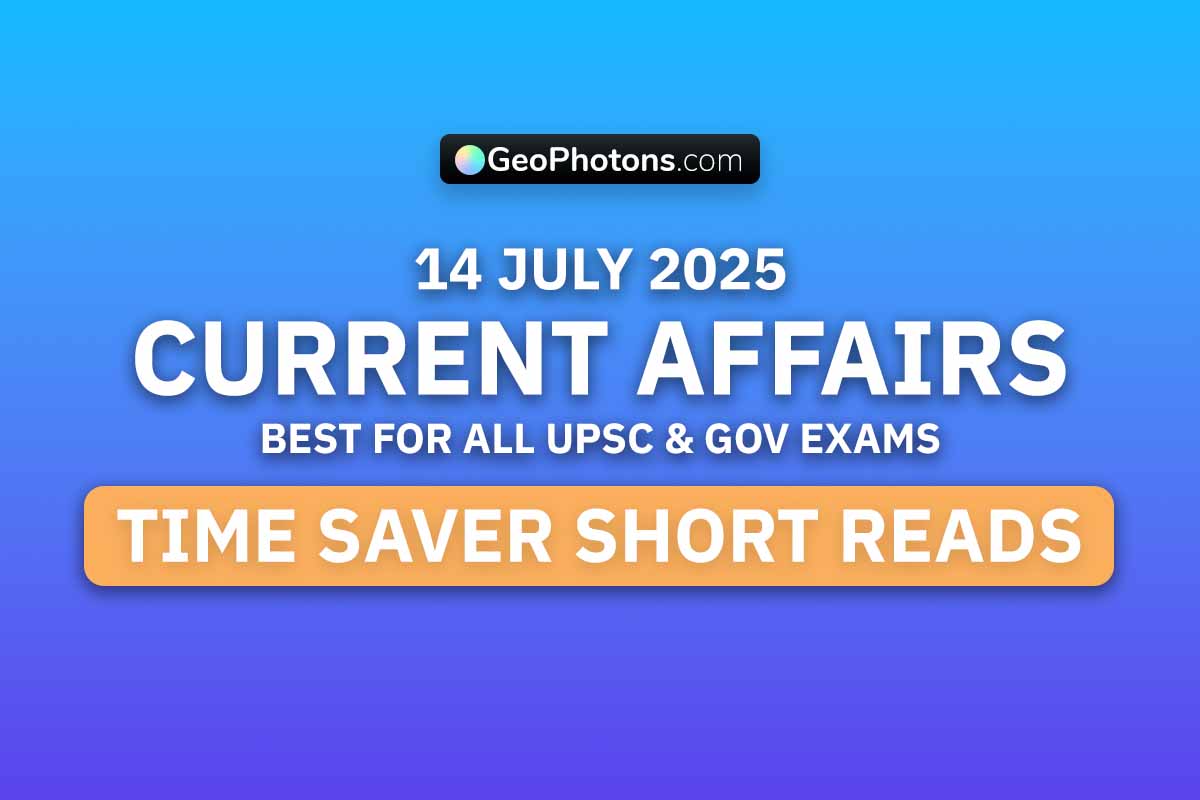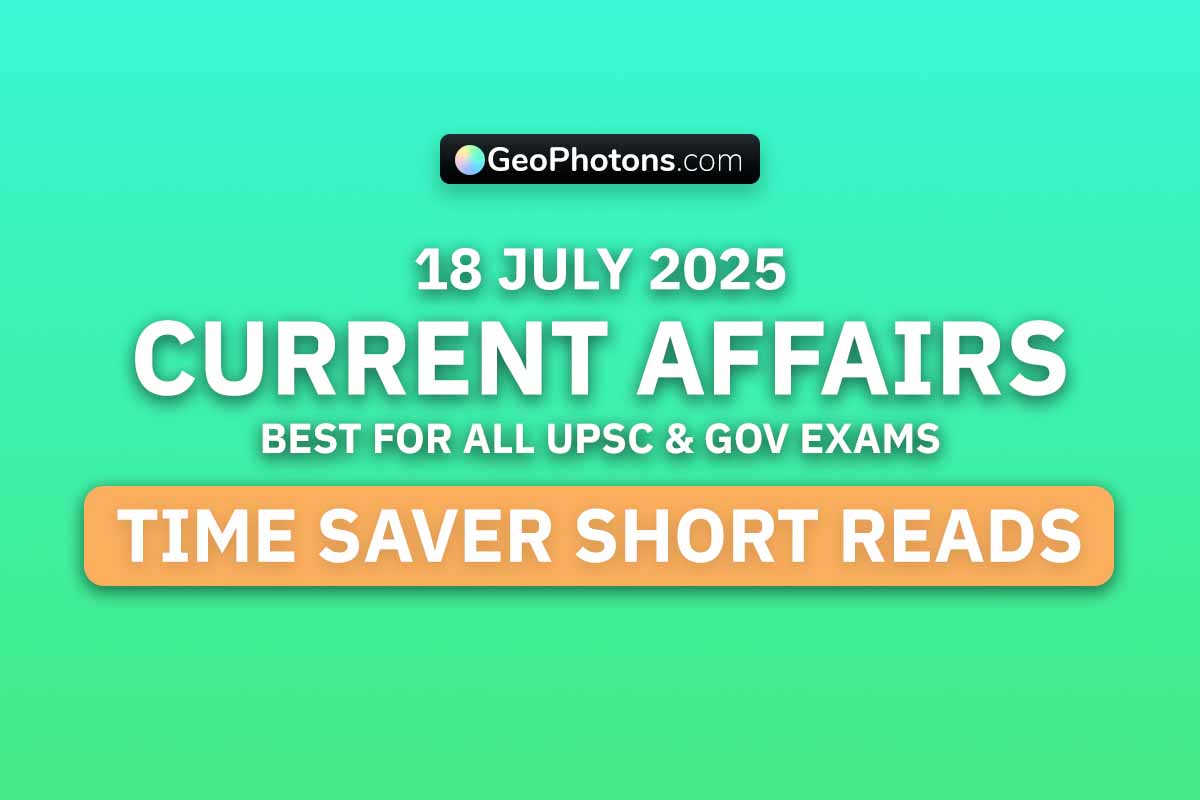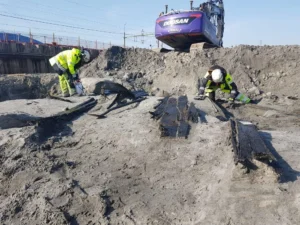Current Affairs 14 July 2025
Current Affairs 14 July 2025. From Anganwadi revamp to global debt traps and seed rights, this week’s current affairs are about India’s future and how the world could shape it.
🇮🇳 National Affairs
Anganwadi Overhaul
Anganwadis reimagined as engines of a healthier, smarter India
Summary: As India gears up for Viksit Bharat 2047, its 1.4 million Anganwadi Centres (AWCs) are set for a radical makeover. Integrated Child Development Services (ICDS), now 50 years old, will shift from basic nutrition hubs to early learning and health centres powered by AI and tech. The Palna Scheme (creche service) covers just 5% of centres today, limiting help for working moms. And urban India? Just 10% of AWCs serve city children—despite nearly 50% of India’s kids expected to live in cities by 2047! These gaps have real costs—36% of kids under 5 are stunted and 67% are anaemic. The government’s new plan blends nutrition, smart education, tech-driven data tracking (like Poshan Tracker), and training for Anganwadi workers to close this gap.
Key Takeaway: Revamping AWCs can spark a silent revolution in India’s early childhood care and women’s empowerment.
Storage Summit
India’s biggest battery & hydrogen tech meet wraps up in Delhi
Summary: From July 8–10, 2025, New Delhi hosted the India Energy Storage Week (IESW 2025). It brought together over 10,000 visitors, 1,000 delegates, and 200+ companies from 30+ countries, making it India’s top energy conference. Union Minister Piyush Goyal unveiled a whopping ₹1 lakh crore R&D fund to push next-gen battery tech. Telangana was honoured for leadership in battery production. The IESA India Hydrogen Report, also released, says India’s hydrogen demand will hit 8.8 million MTPA with a 3% growth rate yearly.
Key Takeaway: Big batteries, bold budgets—India is charging ahead in clean energy.
6G Mission
Scindia launches tech excellence centre to fast-track India’s 6G vision
Summary: Union Minister Jyotiraditya Scindia launched a Hub & Spoke Centre of Excellence in Bengaluru. It’s a combined effort by VTU, VRIF, and TCOE to push India’s telecom innovation. He also checked in on Bharat 6G Alliance—India’s ambitious plan to lead 6G globally by 2030. The event emphasized a stronger, faster, and more inclusive internet for everyone.
Key Takeaway: India’s future internet could be 100x faster—with homegrown tech leading the charge.
Tribal Network
Aadi Karmayogi campaign begins to empower 20 lakh tribal leaders
Summary: The Ministry of Tribal Affairs launched the first Regional Process Lab in Bengaluru under the Aadi KARMAYOGI Abhiyan. It trains State Master Trainers, who will pass skills to grassroots changemakers across Karnataka, Kerala, TN, AP, and Telangana. Backed by mega-schemes like PM-JANMAN and DAJGUA, the campaign aims to improve education, health, and jobs in 63,000 tribal villages, with a total budget of ₹79,156 crore.
Key Takeaway: Tribal youth are now being equipped to be tomorrow’s local heroes.
Cyber Shield
MeitY and BITS Pilani roll out 8-week cybersecurity course
Summary: On July 19, 2025, a new professional cybersecurity course will launch via a tie-up between MeitY and BITS Pilani. It includes online classes, real-time projects, and expert mentorship, all under CERT-In’s guidance. Learners will explore hacking prevention, VPNs, IDS/IPS, legal frameworks, and more. The course targets government, PSU, and private sector staff and will be run from BITS’ Hyderabad campus.
Key Takeaway: India is gearing up with cyber-warriors to tackle 21st-century threats.
Train Safety
Indian Railways to use AI-powered train inspection system
Summary: Indian Railways signed an MoU with DFCCIL to deploy Machine Vision-Based Inspection Systems (MVIS). These smart cameras detect faulty or missing parts in real-time using AI and ML. This will help prevent train accidents, reduce manual checks, and improve reliability. Four units will be installed along key railway routes, making journeys safer for millions.
Key Takeaway: Smart tech is now keeping your train rides smoother—and safer.
ISO Police
Kerala’s Arthunkal Police Station gets ISO-certified for top service
Summary: On July 10, 2025, Arthunkal Police Station became India’s first to get ISO 9001:2015 certification from BIS. This award celebrates its modern tech use, fast grievance redressal, and transparent policing. The reforms are part of the Modernised Cherthala Police Programme, led by ASP Harish Jain.
Key Takeaway: Even police stations are getting quality checks—and Kerala’s leading the way!
Sindoor Bridge
Mumbai’s Carnac Bridge renamed to honor anti-terror mission
Summary: Maharashtra CM Devendra Fadnavis inaugurated the new Sindoor Bridge, replacing the old Carnac Bridge. It honors Operation Sindoor, India’s May 2025 anti-terror action in Pakistan. The 328m-long bridge eases traffic near Crawford Market and erases colonial ties to British governor James Rivett-Carnac.
Key Takeaway: Mumbai got a stronger bridge—and a stronger symbol of Indian pride.
Ganesh Pride
Maharashtra declares Ganeshotsav as a State Festival
Summary: The 132-year-old Sarvajanik Ganeshotsav is now officially a State Festival of Maharashtra. Started in 1893 by Bal Gangadhar Tilak, the festival symbolizes unity and cultural pride. The govt. will now cover festival expenses, including police, infrastructure, and aid. Restrictions on PoP idols have also been lifted following a Kakodkar Committee study.
Key Takeaway: Maharashtra’s most loved festival just got official status—and a modern push.
🟦 International Affairs
Wealth Surge
12 India-born billionaires lead Forbes’ richest immigrants list
Summary: Forbes’ July 2025 list of America’s Richest Immigrants placed India at No. 1 with 12 billionaires, up from 7 in 2022. Tech mogul Jay Chaudhry (Zscaler CEO) ranked 8th with a $17.9 billion net worth. The list includes 125 billionaires from 43 nations, holding $1.3 trillion in combined wealth. Indians now surpass Israeli and Taiwanese immigrant billionaires in the U.S.
Key Takeaway: Indian entrepreneurs are rocking it abroad, especially in tech and finance.
Tourism Growth
India climbs to 8th rank in global travel economy
Summary: The World Travel & Tourism Council (WTTC) ranked India 8th globally in travel sector value for 2024–25, with a $231.6 billion contribution. The USA topped the list, followed by China and Germany. In 2024, travel added $10.9 trillion to the world GDP—10% of the global economy. India’s rise shows a post-COVID boom in both domestic tourism and global travel spending.
Key Takeaway: From Ladakh to Lakshadweep, India’s tourism wave is taking off.
💰 Economy & Business
Debt Crisis
Global South drowning in debt while rich nations turn away
Summary: At a major international summit in Spain, countries of the Global South raised alarm bells: their share of global debt has doubled from 16% in 2010 to 30% in 2023. They paid a record $1.4 trillion just to service debt last year. Many African and Asian nations now spend more on interest payments than on schools, hospitals, or climate action. While countries like the US pay low interest, developing countries are charged 2–12 times higher. This isn’t just about economics—it’s about survival. When borrowing costs crush climate spending and education, entire generations suffer. The UNDP estimates that skewed credit ratings alone cost Africa $70 billion in lost opportunities. India, while better placed, is part of this tug-of-war between paying debt and funding development.
Key Takeaway: Fixing global finance isn’t charity—it’s justice for nations left behind.
Seed Sovereignty
Farmers fight to save India’s right to native seeds
Summary: Indian farmers and scientists are protesting proposed changes to the International Treaty on Plant Genetic Resources, which could dilute India’s control over its indigenous seeds. The treaty’s amendments would require India to share its local plant genes through a global system, possibly bypassing national laws like the PPV&FR Act. That’s scary for Indian farmers who rely on seed saving—an age-old practice protected under Article 9 of the Treaty. India’s concern? If the rules change, farmers may lose the right to save and exchange seeds and global corporations could gain control. Even the State Biodiversity Boards might lose their say if centralised rules kick in.
Key Takeaway: Protecting seed rights means protecting farmer independence and food security.
Eat Right Mission
FSSAI launches a health revolution—starting with your plate
Summary: From heart disease to diabetes, India’s health challenges are changing. Enter Eat Right India, a nationwide mission launched in 2018 and now gaining serious steam. The new 2025 campaign asks Indians to cut salt and oil intake by 10%, and it’s backed by science. Labs-on-wheels now test street food across towns. There’s a mobile app for checking food safety. And AI tools are helping monitor what we eat and where. FSSAI isn’t working alone—it’s tying up with CSIR, ICAR, and even BITS Pilani to study scary things like microplastics in food. This mission blends food, health, and sustainability into one idea: eat safe, eat healthy, and eat local.
Key Takeaway: Small changes on your plate today could save lives and the planet tomorrow.
Insurance Index
BSE launches new index to track India’s insurance sector
Summary: Asia Index, a BSE arm, launched the BSE Insurance Index, covering all insurance stocks from the BSE 1000 list. The index’s base date is June 18, 2018, and its weight limit per stock is 25%. It will help mutual funds, ETFs, and PMS track insurance performance.
Key Takeaway: Want to invest in insurance companies? There’s now an index for that.
Travel Cards
IndiGo and Kotak relaunch credit cards with flight rewards
Summary: IndiGo Airlines and Kotak Mahindra Bank have relaunched their co-branded credit cards with the new BluChip rewards program. Big spenders can earn up to 70,000 BluChips yearly—enough for free flights. Users earn points on bookings, dining, and entertainment, and redeem them for IndiGo travel.
Key Takeaway: Flying often? Now your credit card can pay for your next vacation.
CAMSPay Gateway
CAMS unveils fast, secure payment gateway for Indian businesses
Summary: On July 9, 2025, CAMS launched a next-gen payment gateway, certified by Visa, Mastercard, and RuPay. Built with Mylapay and backed by RBL Bank, it can handle 5,000+ transactions per second. Businesses get real-time dashboards, fraud alerts, and RBI-compliant processing—all in one system.
Key Takeaway: India’s online payments just got faster and smarter for growing startups.
Housing Boost
AIIB funds $100 million for green affordable homes in India
Summary: The Asian Infrastructure Investment Bank (AIIB) signed a $100 million deal with IIFL Home Finance to support affordable housing for low-income families. 20% of funds will go to eco-friendly homes, helping India meet its Paris Agreement goals. The move supports the PMAY-Urban scheme for “housing for all.”
Key Takeaway: Homes for the needy—and greener cities too. A big step in the right direction.
Chip Power
Nvidia becomes world’s first $4 trillion company
Summary: In July 2025, Nvidia reached a $4 trillion market cap, overtaking Microsoft and Apple. It’s now the most valuable company globally, fueled by the AI boom. Nvidia’s chips are used in 90% of AI data centers, including ChatGPT, AWS, and Google Cloud. Its new Blackwell Ultra chips supercharge AI models and real-time systems.
Key Takeaway: From gaming to ChatGPT—Nvidia is now king of the AI hill.
Birla USISPF
Kumar Mangalam Birla joins top U.S.-India business board
Summary: Industrialist Kumar Mangalam Birla has joined the USISPF Board of Directors and its Executive Committee, aiming to deepen India–US economic ties. He’s also Chancellor of BITS Pilani, former head of IIT Delhi, and was awarded the Padma Bhushan (2023) and Global Leadership Award (2025).
Key Takeaway: Birla’s role means stronger business bridges between India and the U.S.
HUL Breakthrough
Priya Nair becomes first woman CEO of Hindustan Unilever
Summary: Priya Nair takes charge of HUL from August 1, 2025—becoming its first woman MD & CEO. A 30-year HUL veteran, she has led brands in Home Care and Beauty & Wellbeing, and was global CMO. She replaces Rohit Jawa and joins the Unilever Leadership Executive (ULE).
Key Takeaway: A glass ceiling just shattered at one of India’s biggest companies.
🔬 Science & Technology
Defence vs Development
India spends big on defence—but at what cost?
Summary: At the NATO summit this June, global powers pledged to raise military spending to 5% of GDP by 2035. India’s already deep in this trend. Our defence budget in 2025 stands at ₹6.81 lakh crore—plus an extra ₹50,000 crore post-Operation Sindoor. Sounds secure? Maybe. But here’s the tradeoff—public health spending is just 1.84% of GDP, far below India’s own target. Programmes like Ayushman Bharat (which covers 58 crore Indians) got just ₹7,200 crore last year. Globally, too, defence spending is squeezing out development money. The UN’s 2025 budget is only $44 billion, and it’s still underfunded. Meanwhile, just 12 days of war between Israel and Iran saw over $1 billion spent on missiles.
Key Takeaway: A safer country isn’t just about tanks—it’s also about schools, hospitals, and hope.
🌱 Environment & Energy
Green Skies
India takes flight with Sustainable Aviation Fuel
Summary: With aviation causing 2.5% of global greenhouse gas emissions, the skies aren’t as clean as they look. India’s solution? Sustainable Aviation Fuel (SAF), a biofuel that works just like jet fuel but with 80% less emissions. SAF can be made from food waste, crop residue (like bagasse and husk), or even algae. India has 500 million tonnes of crop residue annually, a goldmine for green fuel. The government aims for 5% SAF blending by 2030, and 15% by 2040. Sounds simple? Not quite. SAF costs twice as much as regular fuel and needs new storage infrastructure. Still, India is pushing ahead—through global pacts like the Global Biofuel Alliance and tech support via CORSIA.
Key Takeaway: Cleaner air travel isn’t a fantasy—it’s India’s next flight mission.
Mineral Clubs
India joins global race for critical minerals
Summary: As the world shifts from fossil fuels to clean energy, the demand for critical minerals like lithium, cobalt, and rare earths is exploding. India’s stepping up with new alliances like the Quad’s Critical Minerals Initiative and deals with Argentina, Zambia, and Congo. But there’s a hitch—Indian companies often lack the tech and capital to extract or process these minerals. So, we’re also partnering with countries like Japan and Australia to build processing hubs and tech-sharing platforms. If done right, India could lead the green value chain—from mining to manufacturing solar panels and EV batteries. But if we stay only as processors, the real profits may head to the Global North.
Key Takeaway: Controlling minerals today means controlling tomorrow’s energy economy.
Bridge Failures
India’s infrastructure faces a trust test
Summary: In Gujarat, the collapse of the Gambhira Bridge over the Mahi River is a wake-up call. This isn’t a one-off. In recent years, India has seen multiple bridge failures—Nagpur flyover collapse, Aguwani-Sultanganj bridge, and the tragic Morbi incident. The root causes? No real-time monitoring, poor maintenance, overloading, and rushed construction. Unlike Japan or the US, India still lacks digital structural health systems to detect stress or rust. Government departments often clash—ULBs, MoRTH, state PWDs—all in charge, yet no one accountable. Experts suggest visual checks every 6–12 months, load sensors, and AI-driven vibration monitoring.
Key Takeaway: A strong India needs strong bridges—and stronger systems to keep them safe.
📚 Prelims: In News
Interstellar Visitor
Comet 3I/ATLAS races toward the Sun from another star
Summary: Say hello to 3I/ATLAS—a tiny interstellar comet just passing through our solar system! Spotted by NASA’s ATLAS telescope in Chile, it’s the third known object to visit us from outside the solar system. The first two were 1I/ʻOumuamua in 2017 and 2I/Borisov in 2019. This cosmic traveller has a faint gas cloud (called a coma) and a short tail. It’ll come closest to the Sun in July 2025—about 210 million km away, just inside Mars’ orbit. Unlike most solar system comets, this one follows a hyperbolic path, meaning it won’t come back.
Key Takeaway: Some visitors never return—and some remind us how small (and lucky) we are in the universe.
Spine Alert
Scoliosis awareness still low in India
Summary: Scoliosis might sound unfamiliar, but it quietly affects 2–3% of Indians. It’s when the spine curves into an ‘S’ or ‘C’ shape, sometimes causing pain, uneven shoulders, or breathing issues. Girls are at higher risk. It usually begins in childhood or teenage years but can occur later too. Sadly, awareness is very low in India, and research is scarce. Many parents mistake it for posture problems or ignore early symptoms. Doctors say timely diagnosis can help prevent complications. While scoliosis doesn’t affect lifespan, untreated cases can make daily life harder.
Key Takeaway: A crooked spine might be invisible—but it deserves our full attention.
Fish Discovery
New fish species found in Brahmaputra River
Summary: A small, shiny fish from Assam is now officially a new species! Researchers at ICAR–CIFRI discovered Pethia dibrugarhensis in the fast-flowing waters of the Brahmaputra River. It belongs to the Cyprinidae family—the same group as rohu, koi, and goldfish. This fish has a rare black spot on its tail, an incomplete lateral line (used to sense water movement), and no barbels (the feelers some fish use). It lives among mud, stones, and sand, and coexists with other small species. Naming new species isn’t just cool—it helps protect biodiversity and our freshwater ecosystems.
Key Takeaway: India’s rivers still hold secrets—and every fish tells a new story.
📆 Important Days (July 1–14, 2025)
-
July 1 – National Doctors’ Day (India)
Celebrates the birth anniversary of Dr. B.C. Roy. It honours doctors and healthcare workers who work tirelessly to keep the nation healthy. The theme this year focused on “Healing Hands, Caring Hearts.” -
July 6 – International Co-operative Day
Observed on the first Saturday of July, this day recognizes the role of cooperatives in inclusive economic development and social justice. The 2025 theme was “Cooperatives: Partners for Sustainable Future.” -
July 11 – World Population Day
This year’s theme: “Empowering young people to create the families they want in a fair and hopeful world.”
The UN marked this day to reflect on global population issues, especially among youth and marginalized communities. It commemorates the first time Earth’s population reached 5 billion (July 11, 1987). -
July 11 – Srebrenica Genocide Remembrance Day –
Honoring over 8,300 Bosnian Muslims murdered in 1995 during the Bosnian War.
The UN General Assembly officially declared this in 2024, pushing for global awareness, especially among youth, about the horrors of ethnic cleansing. -
July 11 – World Horse Day –
Celebrating the role of horses in human history—from farms to therapy.
Adopted by the UN in 2025, this day calls attention to the declining horse population and the need to protect equine welfare worldwide. - July 14 – World Chimpanzee Day
Marks the day when Dr. Jane Goodall first stepped into Tanzania’s Gombe forest to study wild chimpanzees. It spreads awareness about protecting great apes and their habitats.
📌 Key Takeaways
-
Anganwadi Overhaul: India is reimagining 1.4 million Anganwadi Centres into smart, urban, and rights-based learning hubs aligned with Viksit Bharat 2047.
-
Debt Dilemma: Global South nations now hold 30% of global debt and spend $1.4 trillion annually on repayment—leaving little for education or climate action.
-
Eat Right Revolution: With 3 powerful pillars—safe, healthy, sustainable—FSSAI’s Eat Right India tackles rising lifestyle diseases through public campaigns, mobile labs, and tech.
-
Seed Sovereignty: Proposed Plant Treaty changes could undermine Indian farmers’ rights by enforcing global rules over national biodiversity laws.
-
Clean Aviation: Sustainable Aviation Fuel can cut aviation emissions by 80%, with India targeting 5% blending by 2030 to reduce costs and pollution.
-
Mineral Diplomacy: India joins Quad and MSP clubs to secure minerals like lithium, aiming to shift from just a processor to a full clean-tech powerhouse.
-
Bridge Safety: With rising infrastructure failures like Gambhira Bridge, India needs real-time monitoring, routine audits, and standardised safety laws.
-
Military Tradeoffs: India’s rising defence budget could squeeze funds from health and education. Global SDGs need balance between security and welfare.
-
Comet Sighting: 3I/ATLAS is Earth’s third visitor from another star—reminding us how vast (and mysterious) our galaxy really is.
-
Scoliosis Awareness: 2–3% of Indians are affected, mostly girls, yet awareness remains low. Early detection is key to better outcomes.
-
Fish Discovery: Assam’s Pethia dibrugarhensis joins India’s growing freshwater biodiversity list—highlighting the need for river conservation.
-
Energy Week: India unveiled a ₹1 lakh crore R&D fund and released a new hydrogen report at IESW 2025, boosting its clean energy ambitions.
-
Tech Centre: The new CoE in Bengaluru will power India’s race to 6G and modernize postal services.
-
Tribal Lab: MoTA’s Aadi KARMAYOGI mission kicked off with the first training lab in Bengaluru to empower 20 lakh tribal leaders.
-
Cyber Course: MeitY and BITS Pilani are training professionals nationwide with an 8-week crash course in cybersecurity.
-
Train Tech: Indian Railways will now use AI-enabled MVIS to detect faults in trains—making journeys safer.
-
Police Reform: Kerala’s Arthunkal Police Station is India’s first to get ISO-certified by BIS, showing what modern policing looks like.
-
Bridge Rename: Mumbai’s Carnac Bridge was renamed Sindoor Bridge to honor India’s May 2025 military operation against terrorism.
-
Immigrant Wealth: India has the most billionaire immigrants in the U.S. with Jay Chaudhry among the top 10.
-
Tourism Boost: India ranks 8th globally in travel revenue, showing the sector’s bounce-back after COVID.
-
Insurance Index: BSE launched a dedicated Insurance Index, supporting ETFs and financial benchmarks.
-
Fly & Earn: Kotak and IndiGo reintroduced credit cards that turn everyday spends into free flights.
-
New Gateway: CAMS launched a high-speed, secure payment gateway to support India’s booming ₹83 lakh crore digital market.
-
Green Housing: AIIB’s $100 million partnership with IIFL will fund eco-friendly housing for low-income families.
-
Nvidia Glory: Nvidia became the world’s first $4 trillion company—AI chips are clearly the new oil.
-
Birla’s Entry: Kumar Mangalam Birla’s induction into USISPF’s board will deepen US–India business ties.
-
HUL’s First Woman CEO: Priya Nair breaks barriers and leads a ₹5 lakh crore FMCG giant.
-
World Population Day: Youth empowerment and family planning took center stage this year.
-
Srebrenica Day: A global moment to reflect on hate-fueled genocide and build peace.
-
Horse Day: Horses got their first UN-backed holiday—about time we honored our four-legged heroes.
-
Ganesh Festival: Maharashtra gave its most iconic celebration official status, tying culture with policy.
Also Read – Current Affairs 13 July 2025
Share this content:














Post Comment